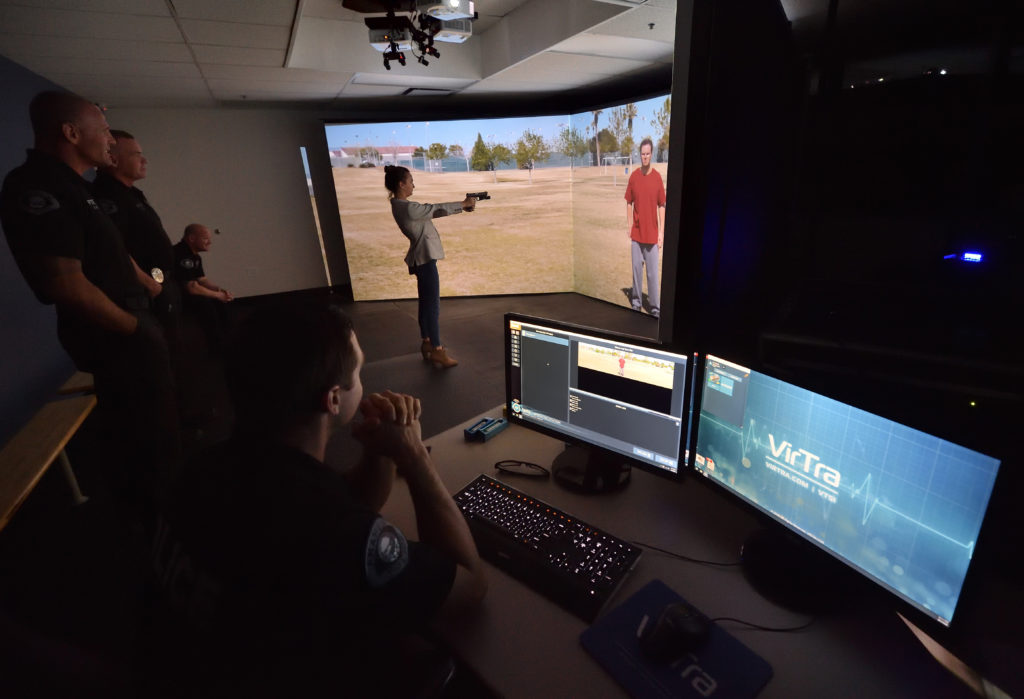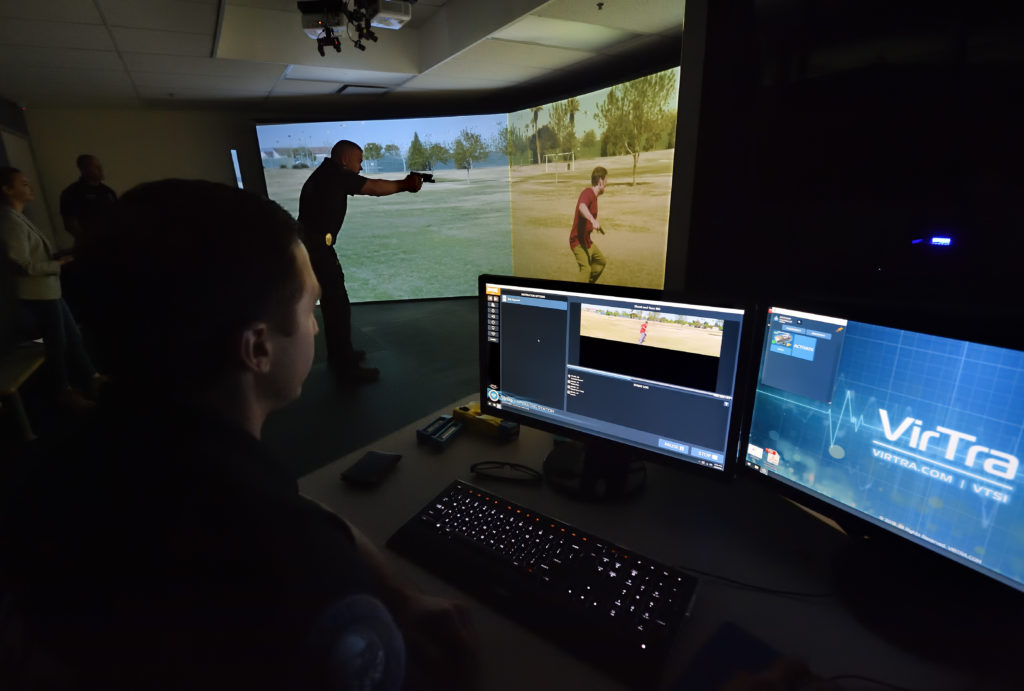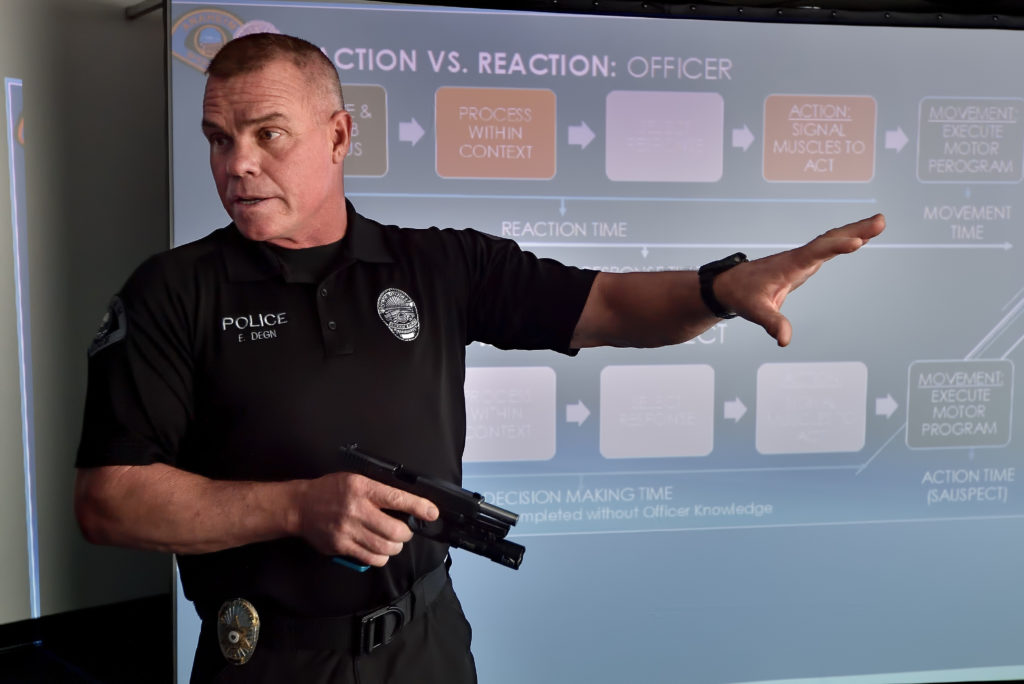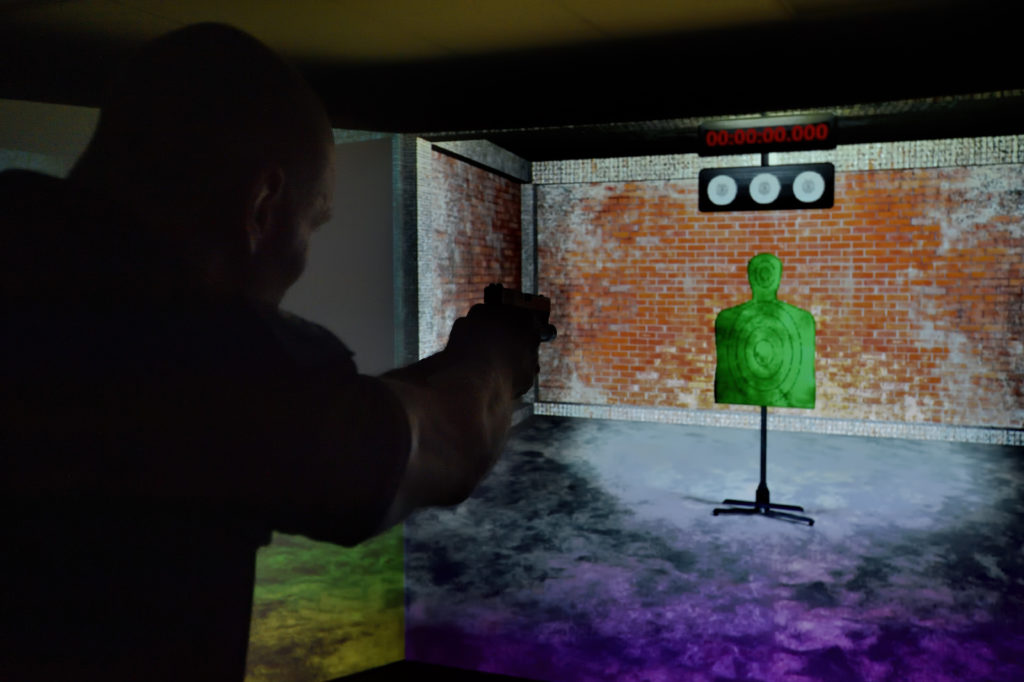The man in the red shirt stood in the park, glaring at me like a hawk focused on its prey.
Even though I could see his left hand, his right hand was hidden, concealed on his side.
I stood there with my hands firmly griped around the Glock 17 pistol, thinking, “Does his right hand hold a weapon that could kill me?”
Before I could even think about my next move, the man’s right hand shot up and a loud bang followed.
I realized it was my gun that was the culprit of the gunfire. I shot the man.
“So good news, your reaction time was great! Bad news is that you just shot an unarmed man, and it doesn’t look too good,” Training Sgt. Dustin Ciscel said.
The man had been only moving his hand to surrender.

Behind the Badge Reporter Rebecca D’Auria receives a first hand demonstration on Anaheim PD’s new training simulator.
Photo by Steven Georges/Behind the Badge
Thankfully, I was not actually involved in a real shooting. Instead, I was face to face with an actor in a virtual reality scenario I was put though using the Anaheim Police Department’s new and improved force options simulator.
The new VirTra simulator is taking the department’s training to new levels.
Backed by force science, this incredibly powerful computer is the innovative training tool that can take officers and put them into virtually any type of situation or scenario they might encounter in the field.
“Most are decision-making based scenarios so we can put an officer in (the simulator) and they have to think on their feet,” Officer Brett Heitman said. “The system incorporates firearms and less-than-lethal weapons, so basically anything that officers might use on the street, they can also use it here.”
The training scenarios that can be done inside the simulator range from shoot or don’t shoot, de-escalation, suicide by cop, active shooter, and even dangerous dog scenarios. Officers’ communication skills also can be put to the test while trying to talk somebody down from a possible suicide.
All of the equipment that can be used in the simulator, from a gun to a taser, use targeting lasers and can be programed down to the type of the bullets used, making each shot ballistically accurate.
While the guns used in the old simulator ran on compressed air, the new ones run on smaller CO2 cartridges.
“Because we’re dealing with budgets and limited round counts, the simulator really helps keep costs down,” Heitman said. “In the old days, someone would just stay at the range day after day and let’s face it, that costs money whereas here it costs CO2.”

Anaheim PD Officer Brett Heitmann, sitting, runs a simulation for Officer Erik Degn as situations based on real life challenge officers during training.
Photo by Steven Georges/Behind the Badge
The simulator also runs on three screens. The officer undergoing training will have a screen in the front and two on their sides.
“Because of where they stand in the simulator now, with the extra screens on their side, they really have been placed in this virtual environment where they can’t perceive everything just by standing still,” Heitman said. “Now things can also happen around them, which makes it all that much more realistic…that coupled with the Threat-Fire device.”
The Threat-Fire device replaces shoot-back cannons and is worn by officers during training. If an officer is shot (or injured) during training, the device will deliver an electric impulse (small shock) that will safely apply stress.
The device tests the trainee’s ability to stay engaged in the scenario and carry on despite the physical distraction.
“The hard thing about the simulators is we have to induce stress in the officers, so it doesn’t just feel like they are at Dave & Buster’s playing a video game. They need that psychological stress that will mimic what they’re facing out on the street,” Ciscel said.

Anaheim PD Officer Erik Degn talks about the post simulator evaluation using APD’s new training simulator.
Photo by Steven Georges/Behind the Badge
“We can’t safely mimic a deadly force situation out in the street, but at least we can use the Threat-Fire and what we’ve seen is once we put that on, the officers’ stress levels do go up because they don’t want to get shocked.”
Training doesn’t stop inside the simulator. Right next door to the simulation room, the department has a gym and a mat room.
“During training if an officer says, ‘Well, I would have chased that person,’ OK, sounds good! Let’s go stick you in the gym and turn on the treadmill for a few minutes,” Ciscel said.
The training sessions can last anywhere from 30 minutes to one hour and usually are done in groups of four.
APD’s goal is to start running every officer though the training using the simulator once every quarter.
While focusing on better physical training for the officers, one of the most important parts of training is helping the officers understand the aftermath of what happened inside the simulator.
After the officers finish their scenario, they are put through a debriefing. In these sessions they will have to explain why they did what they did and learn about any legal issues they might face if that scenario had been real.

Anaheim PD Officer Brett Heitmann demonstrates one of the programs for their new simulator where the weather can be changed from sunlight, to fog, rain, windy or even night time.
The three screen design can sometimes challenge an officer’s peripheral vision as they are tunnel focused on the subject in front of them.
Photo by Steven Georges/Behind the Badge
“Either we would take them through their report writing or if it was deadly force explain that now they will be interviewed by the district attorney,” Ciscel said.
In addition to on-the-job training, the simulator also breaks down response and reaction times in easy-to-understand graphics as well as showing the suspect’s reaction timeline.
Force science studies show officers response time during a shooting is about 0.31 seconds.
Officer Erik Degn explained that somebody with very limited firearms experience can pull a gun from almost anywhere on their body and shoot in a quarter of a second. So even if an officer is at that 0.31 mark, they are still behind.
“So far these trainings have been extremely eye opening for the officers just to realize how far behind the curve they actually are because we are responding to somebody else’s action,” Ciscel said. “We’re always going to be behind so we have to use better tactics. Here, they can learn a lot and the skills definitely translate.”
 Behind the Badge
Behind the Badge




